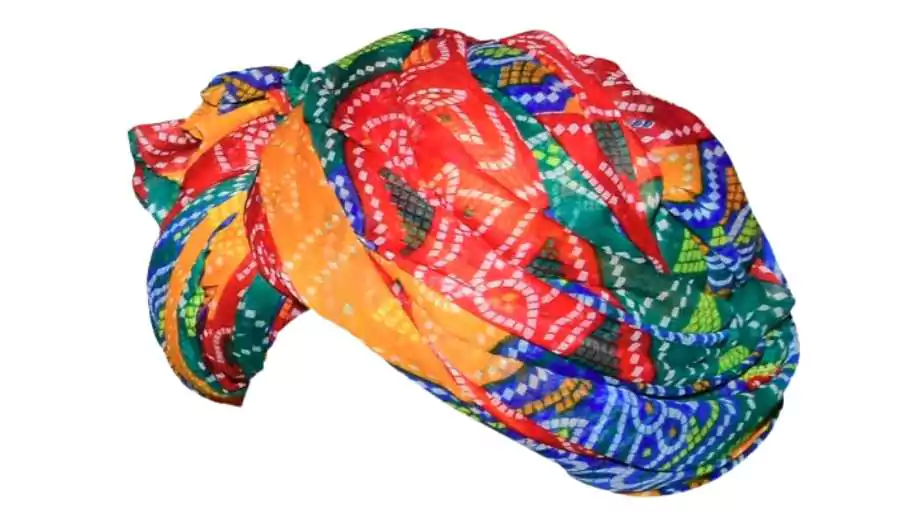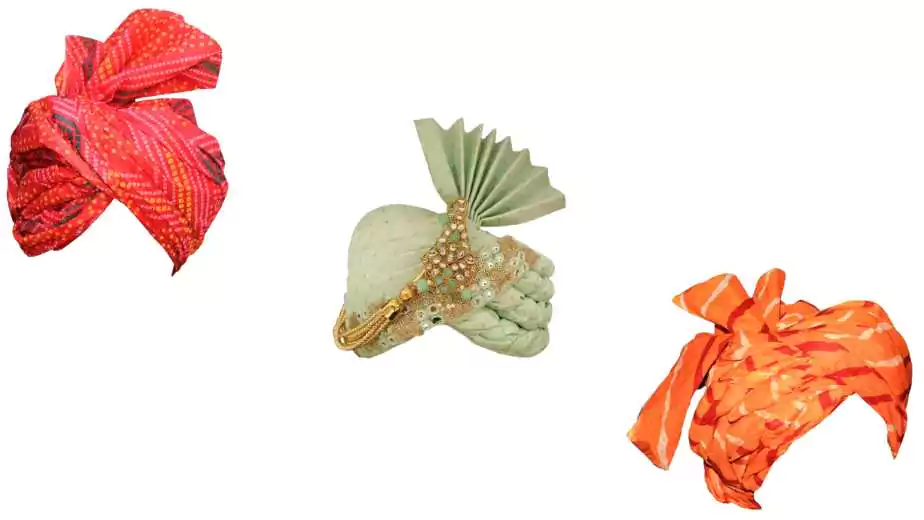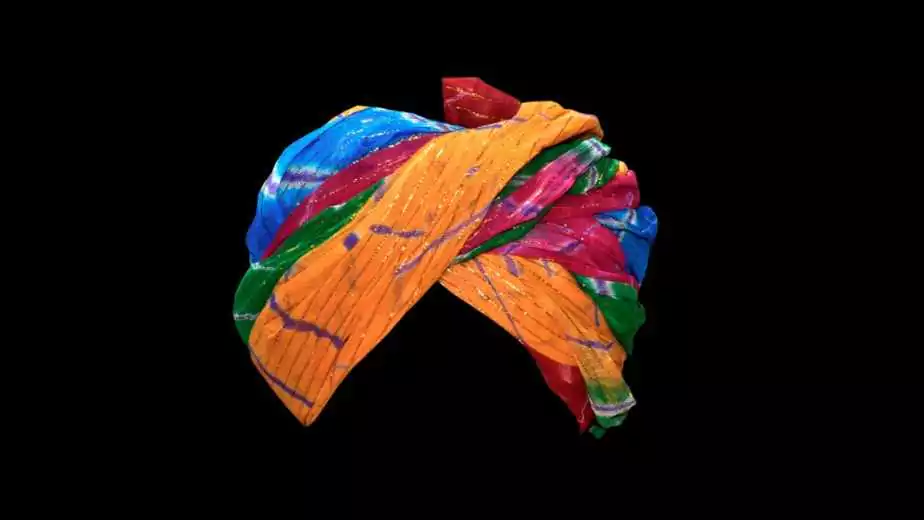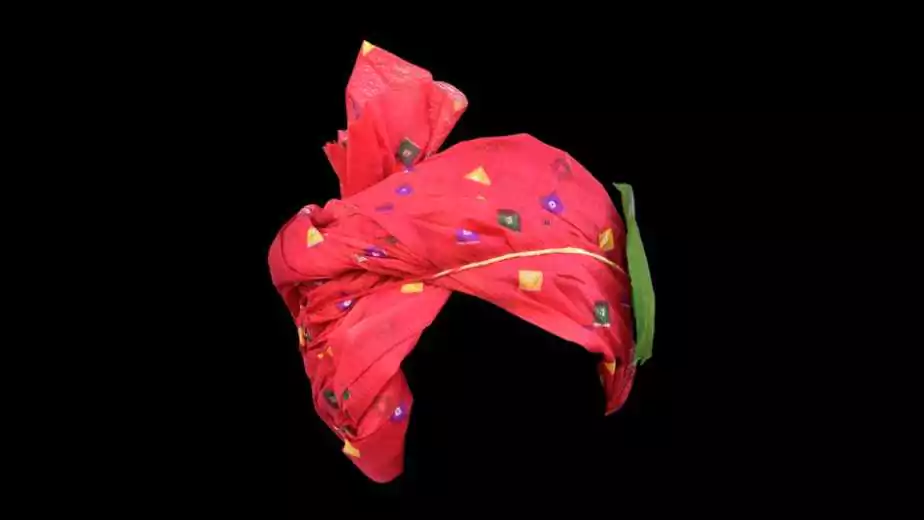How To Wear Rajputi Safa With Style?

The Rajputi Safa, a traditional headgear, holds a place of honour and pride in the rich tapestry of Indian culture, particularly among the Rajputs, a prominent warrior class from the Indian subcontinent. This distinctive turban is not just a piece of cloth wrapped around the head; it is a symbol of honour, bravery, and the rich heritage of Rajputana.
Historically, the Rajputi Safa has been much more than an accessory. It represents the valour and glory of the Rajputs, renowned for their courageousness and chivalry. Each fold and colour of the Safa carries a story, a legacy passed down through generations, making it an integral part of the Rajput cultural identity. The Safa has witnessed battles, royal courts, and grand celebrations, embedding itself as an irreplaceable part of the Rajput ethos.
In this guide, we will delve into the intricacies of how to wear Rajputi Safa with style, ensuring that this majestic piece of tradition is donned with the respect and grace it deserves.
1 Types of Rajputi Safas
The Rajputi Safa, while a singular term, encompasses a myriad of styles, each with its unique flair and significance. These variations are not just aesthetic but also deeply rooted in the geography and history of the regions they originate from.

Styles and Regional Variations
- Jodhpuri Safa: Originating from the historic city of Jodhpur, this style is known for its vibrant colours and elaborate patterns. The Jodhpuri Safa is typically longer than other styles, allowing for more intricate and elaborate wrapping techniques.
- Jaipuri Safa: Hailing from Jaipur, the Pink City, this style is renowned for its lightweight fabric and pastel shades. The Jaipuri Safa is often chosen for its comfort and elegance, especially in warmer climates.
- Mewari Safa: From the land of Mewar, this Safa is distinguished by its width and rich, bold colours. It often features unique geometric patterns, reflecting the traditional art of the region.
- Shekhawati Safa: This style, from the Shekhawati region, is known for its shorter length and is often adorned with tie-dye patterns, making it a distinctive choice for festive occasions.
Popular Colors and Fabrics

The fabric of a Rajputi Safa is as important as its style. Traditionally, Safas were made from cotton, valued for its breathability and comfort. However, in modern times, a variety of fabrics like silk and chiffon are also used, adding a touch of luxury and versatility.
As for colours, the spectrum is wide and symbolic. The most commonly seen colours include:
- Red: A symbol of valour and bravery, often worn by grooms during weddings.
- Saffron: Representing wisdom and valour, saffron is a popular choice for religious and cultural ceremonies.
- White: Symbolising peace and purity, white Safas are typically worn during formal events or ceremonies.
Significance of Colors and Patterns
The colours and patterns of a Rajputi Safa are not mere fashion statements; they are deeply symbolic and often indicative of the wearer’s social status, region, and occasion. For instance, a Safa with gold threads may signify royalty or high social standing, while floral patterns could indicate a festive or celebratory occasion. Understanding these nuances is key to appreciating the full cultural depth of the Rajputi Safa.
2 Step-by-Step Guide to Tying a Rajputi Safa
Mastering the art of tying a Rajputi Safa is a skill that symbolises respect for tradition and culture. While it might seem daunting at first, with practice, anyone can learn to tie a Safa with elegance and precision. Here, we’ll walk you through the basic techniques and provide some tips for achieving a perfect look.
Basic Folding and Pleating Techniques
- Starting the Safa: Begin by finding the midpoint of the Safa cloth. Place it at the centre of your forehead, ensuring that the ends are of equal length on both sides.
- Creating the Base: Wrap the cloth around your head, overlapping each layer slightly, to create a firm base. This step is crucial for maintaining Safa’s structure.
- Pleating: Once the base is secure, start pleating the Safa. Make sure the pleats are uniform in size for a neat appearance. The number of pleats can vary based on personal preference and the style of Safa being tied.
Detailed, Step-by-Step Instructions with Illustrations

- Initial Wrap: Start by wrapping the Safa around your head once, ensuring it’s snug but comfortable.
- Pleating Process: Fold the cloth into even pleats, holding them in place as you wrap them around your head.
- Final Wraps: Continue wrapping the pleated cloth, adjusting the tension to ensure it’s neither too loose nor too tight.
- Securing the End: Tuck the end of the Safa securely into the base to prevent it from unravelling.
Tips for Maintaining Symmetry and Ensuring a Secure Fit
- Even Pleats: Make sure your pleats are of even width throughout the process. Uneven pleats can lead to a lopsided Safa.
- Checking Symmetry: Periodically step back and check your Safa in the mirror to ensure it’s symmetrical.
- Tightness: The Safa should be tight enough to stay in place but not so tight that it’s uncomfortable. A well-tied Safa will feel secure without any pins or additional support.
- Practice Makes Perfect: Don’t get discouraged if your first few attempts aren’t perfect. Tying a Rajputi Safa is an art that improves with practice.
3 Variations in Tying Techniques
The Rajputi Safa, while deeply rooted in tradition, is not immune to regional interpretations and modern influences. These variations add a unique charm and personality to each Safa, making it a true reflection of the wearer’s style and heritage.
Differences in Tying Styles Based on Regions
- Jodhpuri Style: Known for its royal and elegant look, the Jodhpuri Safa is often characterised by its intricate layering and prominent front pleat. This style typically uses brighter colours and may include elaborate patterns.
- Jaipuri Style: The Jaipuri Safa is usually more modest and understated, with subtle pleating and lighter fabrics. This style is popular for its comfort and ease of wearing, especially in warmer climates.
- Other Regional Styles: Each region, from Mewar to Shekhawati, has its unique twist on the Safa, often reflecting local customs and textile traditions.
Modern Twists on Traditional Tying Methods
In recent years, there’s been a trend towards incorporating contemporary elements into the traditional Safa. This includes experimenting with unconventional fabrics like velvet or satin, introducing vibrant and unconventional colours, and even blending styles to create a fusion look. These modern interpretations cater to the younger generation, keen on maintaining a link to their heritage while expressing individuality.
How to Incorporate Accessories?
Accessorising a Rajputi Safa can elevate its grandeur and add a personal touch. Here are some tips:
- Jewels: Adding a brooch or a bejewelled pin can enhance the royal look of the Safa. These are usually placed on the front, just above the forehead.
- Feathers: A traditional Rajputi accessory, feathers, especially peacock feathers, can be tucked into the folds of the Safa for an added regal appearance.
- Strings of Pearls: Draping strings of pearls around the Safa can give it a majestic and sophisticated look, often favoured in royal weddings.
- Customised Embellishments: Personalised embellishments like family crests or monograms are becoming popular, adding a unique and personal element to the Safa.
4 When and Where to Wear a Rajputi Safa?
The Rajputi Safa is not just a symbol of heritage but also a versatile accessory that can be worn on various occasions, reflecting the wearer’s respect for tradition and culture.
Traditional Occasions
- Weddings: Perhaps the most common and significant occasion for wearing a Rajputi Safa is a wedding. Here, it symbolises honour and respect. The groom and male members of both families often wear Safas, colour-coordinated with their outfits.
- Festivals: During traditional festivals like Diwali, Dussehra, or regional festivals, the Safa adds a festive and ceremonial touch to the attire.
- Religious Ceremonies: In religious ceremonies and functions, wearing a Safa is a sign of reverence and devotion. The colour and style of the Safa may vary depending on the occasion’s solemnity.
Contemporary Settings
In recent years, the Rajputi Safa has found its way into more contemporary settings:
- Cultural Events: At cultural gatherings or Indian classical music concerts, the Safa serves as a symbol of cultural pride.
- Formal Occasions: High-profile meetings or gatherings, especially those with a cultural or traditional theme, are also appropriate occasions for donning a Safa.
Dress Code Etiquette and Pairing with Traditional Attire
- Matching with the Outfit: The Safa should complement the overall outfit. For weddings, it’s often matched with the colour scheme of the sherwani or kurta.
- Fabric Coordination: The fabric of the Safa should suit the occasion. Silk or velvet Safas are more suited for formal events, while cotton ones are better for casual or outdoor gatherings.
- Accessorising: When wearing a Safa, minimise other head accessories. Let the Safa be the focal point of your headwear.
- Footwear: Traditionally, juttis or mojaris are the preferred choice of footwear when wearing a Safa, complementing the traditional look.
- Jewellery: Depending on the occasion, traditional Rajasthani jewellery like a neckpiece or kamarbandh can be paired with the Safa for an added royal touch.

5 Maintenance and Care for Your Rajputi Safa
A Rajputi Safa, with its rich colours and delicate fabrics, requires careful maintenance to preserve its beauty and longevity. Here are some essential tips on cleaning, storage, and handling wear and tear.
Cleaning and Storage Tips
- Cleaning Process: Most Rajputi Safas should be dry cleaned due to their delicate fabrics and colours. Avoid machine washing or harsh detergents, as they can damage the fabric and fade the colours.
- Storage: Store your Safa in a cool, dry place. Wrap it in a soft, breathable cloth, preferably muslin, to protect it from dust and moisture. This is particularly important for Safas made from silk or other delicate materials.
- Avoid Folding: Instead of folding, roll the Safa to prevent creases and maintain its shape. Store it in a horizontal position to avoid any undue stress on the fabric.
Handling Common Wear and Tear
- Minor Repairs: For small tears or loose threads, a careful hand stitch can be more effective than a machine repair. Always use thread that closely matches the Safa’s fabric.
- Pleat Care: If the pleats of the Safa become disturbed, gently iron them at a low temperature. Place a thin cloth over the Safa while ironing to protect the fabric.
- Colour Fading: Safas with bright colours or intricate patterns should be kept away from direct sunlight when stored, as prolonged exposure can lead to fading.
Preserving Color and Fabric Quality Over Time
- Avoid Chemical Exposure: Keep your Safa away from harsh chemicals, including perfumes and hair sprays, as they can stain the fabric or cause discolouration.
- Humidity and Moths: Protect the Safa from excessive humidity, which can lead to mildew, and use natural moth repellents like cedar balls to prevent damage from insects.
- Regular Checks: Periodically inspect your Safa for any signs of wear or damage, and address issues promptly to prevent further deterioration.
6 Wrapping Up
As we’ve explored throughout this guide, the Rajputi Safa is not just a piece of attire; it is a symbol of honour, tradition, and the rich cultural heritage of Rajasthan. Its vibrant colours, intricate pleating, and elegant styles speak volumes about the Rajputi valour and pride. From being a staple in traditional ceremonies to making its presence felt in modern-day celebrations, the Safa continues to be an emblem of the Rajasthani spirit.
Community Q&A
About This Article
This article has been viewed 67 times.



